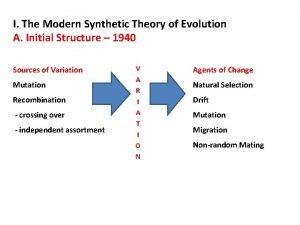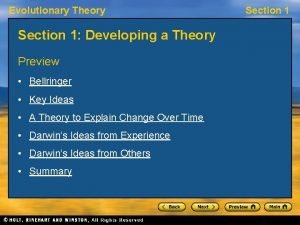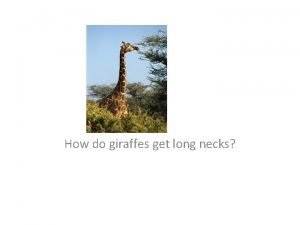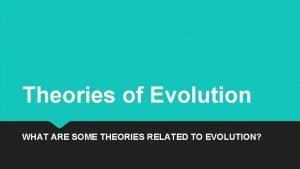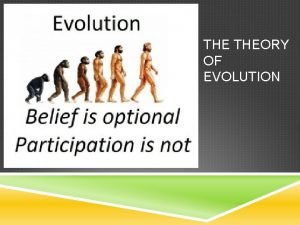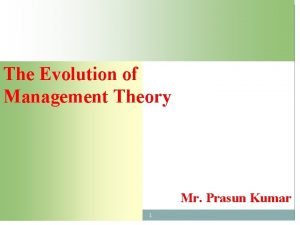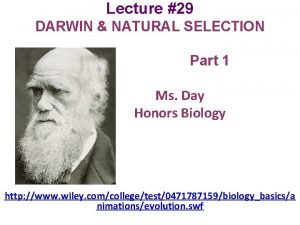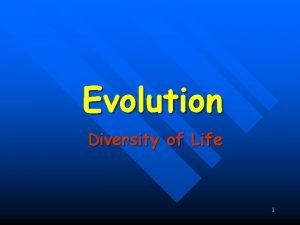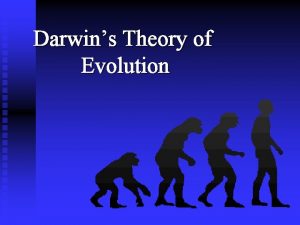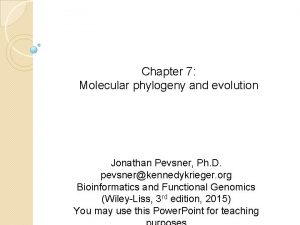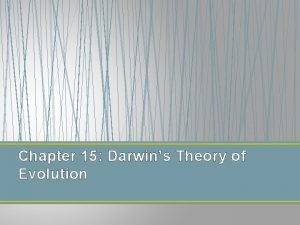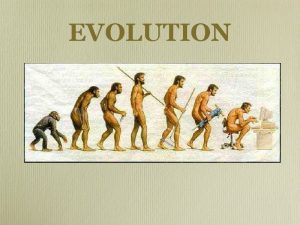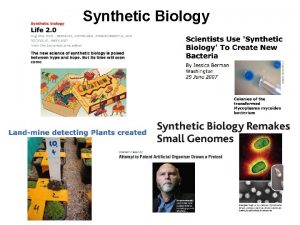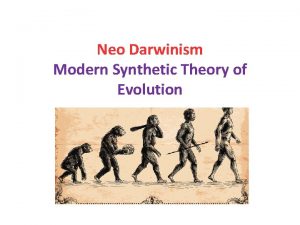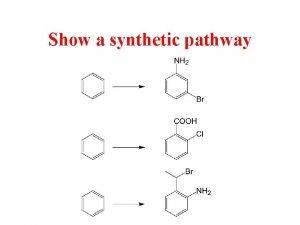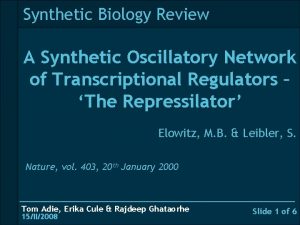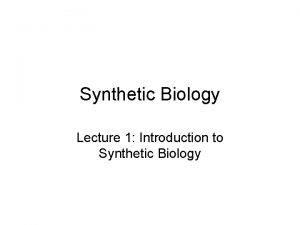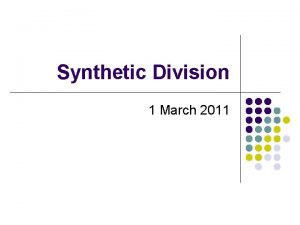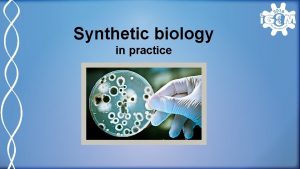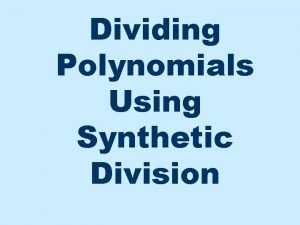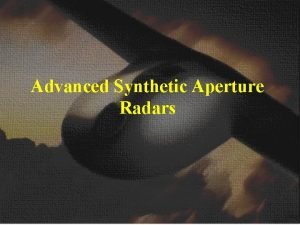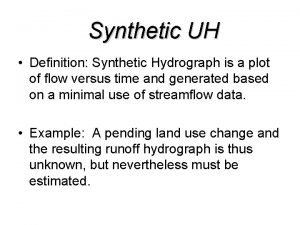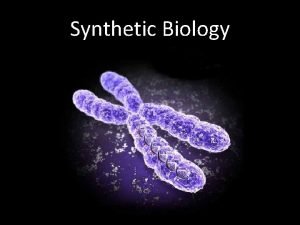I The Modern Synthetic Theory of Evolution A

















- Slides: 17

I. The Modern Synthetic Theory of Evolution A. Initial Structure – 1940 Sources of Variation Mutation Recombination - crossing over - independent assortment V A R I A T I O N Agents of Change Natural Selection Drift Mutation Migration Non-random Mating

B. Population Genetics 1. Hardy Weinberg a. Definitions: b. Basic computations: 1. Determining the Gene and Genotypic Array: Individuals AA Aa aa 60 80 60 (200)

B. Population Genetics 1. Hardy Weinberg a. Definitions: b. Basic computations: 1. Determining the Gene and Genotypic Array: AA Aa aa Individuals 60 80 60 (200) Genotypic Array 60/200 = 0. 30 80/200 =. 40 60/200 = 0. 30 =1 ''A' alleles 120 80 0 200/400 = 0. 5 'a' alleles 0 80 120 200/400 = 0. 5

B. Population Genetics 1. Hardy Weinberg a. Definitions: b. Basic computations: 1. Determining the Gene and Genotypic Array 2. Short Cut Method: - Determining the Gene Array from the Genotypic Array a. f(A) = f(AA) + f(Aa)/2 =. 30 +. 4/2 =. 30 +. 2 =. 50 b. f(a) = f(aa) + f(Aa)/2 =. 30 +. 4/2 =. 30 +. 2 =. 50 KEY: The Gene Array CAN ALWAYS be computed from the genotypic array; the process just counts alleles instead of genotypes. No assumptions are made when you do this.

B. Population Genetics 1. Hardy Weinberg a. Definitions: b. Basic computations: c. Hardy-Weinberg Equilibrium: 1. If a population acts in a completely probabilistic manner, then: - we envision an infinitely large population with no migration, mutation, or selection, and random mating. - we could calculate genotypic arrays from gene arrays - the gene and genotypic arrays would equilibrate in one generation

B. Population Genetics 1. Hardy Weinberg a. Definitions: b. Basic computations: c. Hardy-Weinberg Equilibrium: Initial genotypic freq. Gene freq. Genotypes, F 1 Gene Freq's Genotypes, F 2 AA Aa aa 0. 4 0. 2 f(A) = p =. 4 +. 4/2 = 0. 6 p 2 =. 36 2 pq =. 48 f(A) = p =. 36 +. 48/2 = 0. 6. 36 . 48 1. 0 f(a) = q =. 2 +. 4/2 = 0. 4 q 2 =. 16 = 1. 00 f(a) = q =. 16 +. 48/2 = 0. 4. 16 1. 00

B. Population Genetics 1. Hardy Weinberg 2. Effects of Different Agents - mutation 1. Consider a population with: f(A) = p =. 6 f(a) = q =. 4 2. Suppose 'a' mutates to 'A' at a realistic rate of: μ = 1 x 10 -5 3. Well, what fraction of alleles will change? 'a' will decline by: qm =. 4 x 0. 00001 = 0. 000004 'A' will increase by the same amount. 4. So, the new gene frequencies will be: p 1 = p + μq =. 600004 q 1 = q - μq = q(1 -μ) =. 399996…. VERY LITTLE EFFECT on GENE FREQ’s

B. Population Genetics 1. Hardy Weinberg 2. Effects of Different Agents - migration p 1 = 0. 2 q 1 = 0. 8 p 2 = 0. 7 q 2 = 0. 3 suppose migrants immigrate at a rate such that the new immigrants represent 10% of the new population

B. Population Genetics 1. Hardy Weinberg 2. Effects of Different Agents IMPORTANT EFFECT, BUT MAKES POPULATIONS SIMILAR AND INHIBITS DIVERGENCE AND ADAPTATION TO LOCAL CONDITIONS (EXCEPT IT MAY INTRODUCE NEW ADAPTIVE ALLELES) - migration p 1 = 0. 2 q 1 = 0. 8 p(new) = p 1(1 -m) + p 2(m) = (0. 2)(0. 9) + (0. 7)(0. 1) = 0. 25 p 2 = 0. 7 q 2 = 0. 3 suppose migrants immigrate at a rate such that the new immigrants represent 10% of the new population

B. Population Genetics 1. Hardy Weinberg 2. Effects of Different Agents - non-random mating 1. Positive Assortative Mating offspring F 1 AA Aa aa . 2 . 6 . 2 ALL AA 1/4 AA: 1/2 Aa: 1/4 aa ALL aa . 2 . 15 +. 3 +. 15 . 2 . 35

B. Population Genetics 1. Hardy Weinberg 2. Effects of Different Agents - non-random mating 1. Positive Assortative Mating B. Inbreeding - reduction of heterozygosity across the entire genome, at a rate that correlates with the degree of relatedness.

B. Population Genetics 1. Hardy Weinberg 2. Effects of Different Agents - Genetic Drift 1. The organisms that actually reproduce in a population may not be representative of the genetics structure of the population; they may vary just due to sampling error

B. Population Genetics 1. Hardy Weinberg 2. Effects of Different Agents - Genetic Drift 2. patterns

B. Population Genetics 1. Hardy Weinberg 2. Effects of Different Agents - Genetic Drift 2. patterns

- “Genetic Bottleneck” If a population crashes (perhaps as the result of a plague) there will be both selection and drift. There will be selection for those resistant to the disease (and correlated selection for genes close to the genes conferring resistance), but there will also be drift at other loci simply by reducing the size of the breeding population. European Bison, hunted to 12 individuals, now number over 1000. Cheetah have very low genetic diversity, suggesting a severe bottleneck in the past. They can even exchange skin grafts without rejection… Fell to 100’s in the 1800 s, now in the 100, 000’s

B. Population Genetics 1. Hardy Weinberg 2. Effects of Different Agents - Selection: Differential reproductive success A. Measuring “fitness” – differential reproductive success 1. The mean number of reproducing offspring (or females)/female 2. Components of fitness: - probability of female surviving to reproductive age - number of offspring the female produces - probability that offspring survive to reproductive age

B. Population Genetics 1. Hardy Weinberg 2. Effects of Different Agents - Selection: Differential reproductive success p = 0. 4, q = 0. 6 AA Aa aa Parental "zygotes" 0. 16 0. 48 0. 36 prob. of survival (fitness) 0. 8 0. 2 Relative Fitness 1 1 0. 25 Survival to Reproduction 0. 16 0. 48 0. 09 = 0. 73 Geno. Freq. , breeders 0. 22 0. 66 0. 12 = 1. 00 Gene Freq's, gene pool p = 0. 55 Genotypes, F 1 0. 3025 = 1. 00 q = 0. 45 0. 495 0. 2025 = 100
 Modern synthetic theory of evolution notes
Modern synthetic theory of evolution notes Modern evolution theory
Modern evolution theory The image below shows phiomia an ancestor of elephants
The image below shows phiomia an ancestor of elephants Lamarck's theory of evolution
Lamarck's theory of evolution Developmental homologies
Developmental homologies Evolution of management theory
Evolution of management theory 3 types of natural selection
3 types of natural selection Lamarck’s theory of evolution.
Lamarck’s theory of evolution. What was lamarck's theory of evolution
What was lamarck's theory of evolution Chapter 15 darwin's theory of evolution section 15-1
Chapter 15 darwin's theory of evolution section 15-1 Neutral theory of molecular evolution notes
Neutral theory of molecular evolution notes Chapter 17 darwins theory of evolution
Chapter 17 darwins theory of evolution Shaping evolutionary theory
Shaping evolutionary theory Chapter 15 darwin's theory of evolution section 15-1
Chapter 15 darwin's theory of evolution section 15-1 Chapter 15 darwin's theory of evolution section 15-1
Chapter 15 darwin's theory of evolution section 15-1 Charles darwin theory of evolution
Charles darwin theory of evolution Who formulated theory of evolution? *
Who formulated theory of evolution? * Lamarck theory of evolution notes
Lamarck theory of evolution notes
